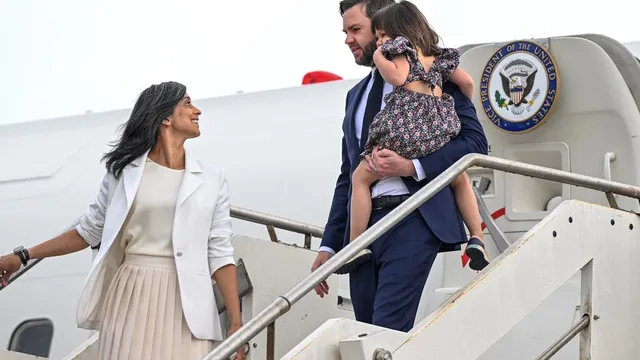
JD Vance arrives in India to strengthen trade ties amid tariff tensions
2025-04-23 17:30- U.S. Vice President JD Vance arrived in India for talks focused on economic opportunities and trade agreements.
- His visit includes meetings with Indian officials, cultural engagements, and aims to strengthen bilateral relations.
- The trip signifies a pivotal moment for U.S.-India relations, particularly amidst ongoing tensions related to tariffs and competing trade interests.
Express your sentiment!
Insights
On April 21, 2025, U.S. Vice President JD Vance arrived in India for a significant four-day visit. This visit is crucial as it comes during pressing negotiations between India and the United States aimed at establishing a bilateral trade agreement. The discussions primarily focus on reducing trade barriers posed by tariffs, especially amidst a complicated trade war involving both the U.S. and China. Vance’s delegation includes his wife and children, highlighting the personal angle of this diplomatic affair. During his visit, JD Vance is scheduled to meet with Indian Prime Minister Narendra Modi on the first day to discuss economic ties and avoid upcoming U.S. tariffs that could heavily impact various sectors in India, particularly agriculture and high-end machinery. This partnership aims to address the challenges posed by Trump’s tariffs that had previously been set at 26% for India under the previous administration. Additionally, Vance's trip underscores the deepening relationship under the Trump administration, particularly after Modi's previous visit to Washington. The ongoing negotiations target a doubling of bilateral trade to $500 billion by 2030, with both nations emphasizing a commitment to enhancing their strategic cooperation against rising Chinese influence in the region. Vance's family ties to India, through his wife Usha, add a unique layer to this visit, showcasing the personal bonds influencing diplomatic channels. In the broader context, the timing and intentions behind this visit reflect significant geopolitical dynamics, where India is seeking to balance its foreign relations amid U.S.-China tension. With Vance’s arrival, the expectation is that it will facilitate negotiations and foster a “mega partnership” aimed at enhancing mutual economic benefits. Such interactions are essential for India to navigate the complexities of trade and diplomacy in an increasingly competitive global landscape.
Contexts
The trade relations between the United States and India have experienced significant developments in recent years, reflecting the growing economic partnership and mutual interests of both nations. This evolving rapport is underscored by various trade agreements, ongoing negotiations, and strategic collaborations aimed at enhancing bilateral trade. As of April 2025, the focus remains on addressing trade imbalances, tariff reductions, and reinforcing supply chain resilience to foster economic growth in both countries. The United States continues to support India's position in the global economy, recognizing its potential to be a significant partner in areas such as technology, manufacturing, and digital services. The introduction of new tariffs in recent years and respective retaliations have occasionally strained relations. However, both nations have shown a commitment to dialogue and resolving disputes through diplomatic channels and multi-level discussions. In 2023, significant steps were taken to reevaluate existing tariffs on various products, with an aim to facilitate smoother trade flows. Coupled with the ongoing negotiations regarding the Bilateral Trade Agreement, the nations are working towards an improved framework that could potentially increase trade volume and simplification of regulatory processes. Moreover, the recent emphasis on climate change and sustainability has positioned India and the U.S. to collaborate in green technologies and renewable energy sectors. Joint ventures and investments in clean energy initiatives are seen as vital components of the bilateral relationship. This partnership is not only focused on trade but also addresses global challenges such as climate mitigation and sustainable development, presenting both countries as leaders in the transition towards greener economies. In conclusion, the trajectory of U.S.-India trade relations appears positive, with both nations taking proactive steps to strengthen their economic ties. Continued commitment to dialogue and cooperation in trade practices, alongside investments in key sectors, will likely enhance the partnership. The potential for shared growth remains significant, providing opportunities for both countries to thrive and support each other's economic objectives moving forward.